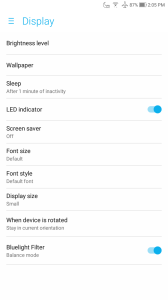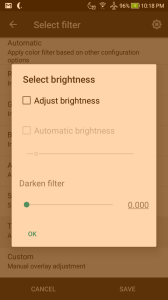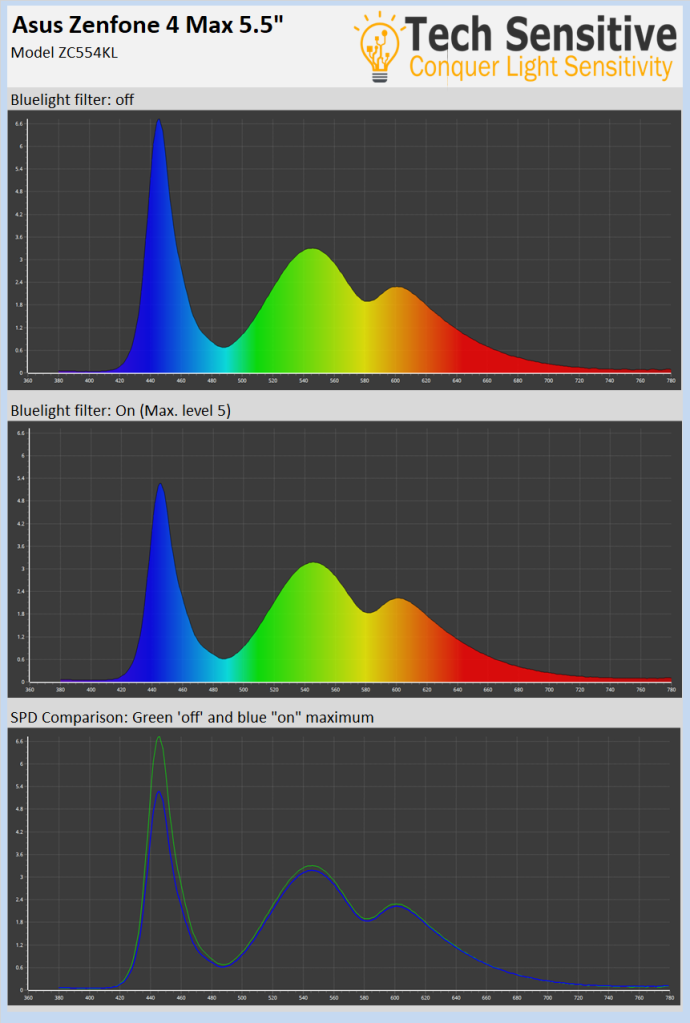ASUS is a well-known company in the laptop and computer parts industry, but is still not a household name when it comes to cellphones.
The appeal of the ASUS Zenfone 4 Max is twofold: price and battery size. The MSRP is a very reasonable $200 USD. The battery capacity is a whopping 5,000 mAh. For perspective, most cellphones are equipped with battery capacities around 3,000 mAh.
Today we’re looking at the North American 5.5″ variant, model ZC554KL (X00ID). Specifications can be found here.
Be mindful that our findings are limited to the 5.5″ variant and not the 5.2″ model ZC520KL.
SUMMARY OF FINDINGS
Mild flicker is present at brightness levels of 23% and below. Color output is not great and the built-in blue light filter is not sufficiently aggressive. Users sensitive to blue light will require third-party software, which actually works well. The relatively low display resolution means text won’t appear as crisp and high contrast as more expensive devices but the large default size of the text helps offset this issue.
If you’re willing to tolerate the mild flicker, text that is good but not particularly crisp, and you don’t mind additional software to further reduce the blue light output of the display, then the Zenfone 4 Max 5.5″ may be reasonably tolerated. For those most sensitive, and users not tech savvy, this device isn’t is suitable choice.
FLICKER
Flicker can contribute to headaches and impaired visual performance. At brightness levels of ~24% and above no flicker was detected on the display of the Zenfone 4 Max 5.5″. We did, however, detect flicker at brightness settings of ~23% and below.
How likely is this particular flicker to contribute to your symptoms? There are a few mitigating factors that indicate it may not be a problem for most. Firstly, the flicker frequency is relatively high at 2,400 cycles per second. This is far better than the more common and aggravatingly low frequency of 200 Hz. Secondly, the flicker is only present between 0%-23% brightness. Furthermore, during each flicker cycle the device isn’t blasting your eyes with short bursts of maximum brightness, like traditional pulse-width modulation flicker. Rather, the flicker cycles mean rapid switching between states of very low brightness and ‘off’.
Below are the flicker characteristics, illustrated. You’ll see flicker at 0% and 15% brightness levels we captured. In our testing this flicker was present until ~24% brightness. At that point flicker was no longer present all the way up to and including maximum brightness.
SETTING TO AVOID FLICKER
If you’re most symptomatic and ultra-diligent you’ll want to, at the very least, avoid dropping the display brightness below ~24%. As the brightness levels aren’t numbered but are rather an analogue slider, below is the brightness slider set to the minimum brightness level short of triggering the flicker.
If you’re especially sensitive to flicker then this brightness level will be too high for use in darker environments, so third-party software will be necessary.
The third-party software we recommend in this case is cf.lumen (as you’ll probably also want this software to adjust color, as set out below). To achieve low brightness without flicker, first set your system display brightness slider to not less than 24% so to avoid flicker. To then further reduce brightness inside the cf.lumen at. Navigate to cf.lumen options -> Master filter mode -> top right cog/widget -> Darken filter.
With this combination you’ll be able to avoid all measurable flicker while using the Zenfone 4 Max at any desired brightness level.
COLOR SPECTRUM OUTPUT
The default color output of the Zenfone 4 Max has a rather harsh, cold blue appearance to it. The measured CCT is 7,049K indicating that it’s above the 6,500K targeted for color accuracy and even further above what those most sensitive will find comfortable.
Thankfully, Asus included such a blue light filter mode in the system settings of the Zenfone 4 Max, but the usefulness is quite limited by not allowing users to select more aggressive settings. When the filtering is ‘on’ and maximum setting selected, it reduced the blue light output by around ~20% bringing the CCT down to a measured 6,113K — still far too high for our liking.
Regardless of how helpful this is, the blue light filter may be enabled by selecting ‘settings’ -> ‘display’ then scrolling to the bottom.
 It’s worth noting that we found hidden settings by selecting and holding down the “Bluelight Filter” button, but unfortunately it didn’t reveal anything more useful.
It’s worth noting that we found hidden settings by selecting and holding down the “Bluelight Filter” button, but unfortunately it didn’t reveal anything more useful.
Instead of the built-in blue light filter, we installed cf.lumen to achieve more aggressive blue light filtering. The settings we found most comfortable were activating the built-in filtering to the maximum ‘Level 5’ in addition to configuring cf.lumen to a color temperature of 2,000K. We don’t usually recommend using a combination of color filters but this appeared most effective.
The Zenfone 4 Max 5.5″ is well-suited to third-party filtering software due to the navigation buttons being physical buttons on the bottom bezel rather than on-screen buttons. This avoids an annoying, inconsistent application of the color filtering software.
BRIGHTNESS RANGE
The Zenfone 4 Max has an exceptionally high maximum brightness, which won’t be a helpful feature for those most light sensitive. The more important minimum brightness level is average, which is still higher than we would like.
For those pursuing flicker-free use, and consequently not lowering the system brightness slider below ~24%, brightness will certainly be too high to use in darker environments without third-party software like cf.lumen.
POLARIZED LENS COMPATIBILITY
For those sensitive to light few accessories are more valuable than polarized sunglasses. Polarized lenses work by filtering out photons oscillating horizontally. While natural light from the sun oscillates in all orientations, light from displays on most devices will all share a single orientation by design. If that orientation happens to be horizontal to your polarized lenses then the light may be blocked in whole or in part, leaving the device unusable with polarized lenses.
Our measurements are performed using reference Maui Jim ‘276 Manu 65’ sunglasses equipped with brown/bronze polarized lens.
In this case we found the following percentages of light were blocked by the polarized filter in our sunglasses:
Portrait orientation: 0% of the light is blocked by the polarized filter
Landscape orientation: ~50% of the light is blocked
In other words, the Zenfone 4 Max 5.5″ can be used in portrait mode (lengthwise) without issue. In landscape orientation (sideways, wide) users lose roughly half the brightness while wearing such sunglasses.
This device is suitable for those who rely on polarized glasses.
OTHER CONSIDERATIONS
The default user interface is quite large and easy to see and read. Those with poor eyesight and those sensitive to small on-screen elements will find this helpful.
The display resolution is a relatively low 1280 x 720 pixels. That means images and text are not as crisp and sharp as most other devices. It’s perfectly usable but if you have good eyesight you will notice a difference, even if it may not bother you.
The Zenfone 4 Max is the first of the ‘Max’ line to sport dual cameras. One has a typical field of view while the other is wide angle. Unfortunately both produce not-great photos, but in fairness are competitive with other devices at this price point. Be aware that activating the camera app greatly increases the display’s brightness until the camera app is closed. The increased brightness when opening the camera app cannot be avoided.
System performance is actually quite good and leaves nothing to be desired.
SUMMARY OF RECOMMENDED SETTINGS
If you’re sensitive to flicker, brightness or harsh color you’ll need to resort to third-party software to use the Zenfone 4 Max. The good news is that cf.lumen solves these problems once configured properly. It’s a bit cumbersome to install and configure, so don’t miss the video guide here.
Once installed set the built-in blue light filter to maximum and your color temperature in cf.lumen to 2,000K. When reducing brightness use the system brightness slider between 0-100% if you’re not concerned with flicker and use the cf.lumen darkening feature to bring minimum brightness even lower than the 0% allowed on the system brightness slider. For those concerned with flicker, to achieve low brightness operation leave the brightness slider at not less than ~25%, then go into cf.lumen to reduce the brightness of the image displayed by setting the ‘darken filter’.
CONCLUSION
We really wanted to like the Zenfone 4 Max. At the end of the day it’s not an ideal device for those most sensitive. If you’re sensitive to blue light then it’s possible to salvage this device by using third-party software. But, the extra steps necessary when using the third-party software is cumbersome enough to dissuade us from recommending purchase of the Zenfone 4 Max for those most sensitive.
For those who are drawn to the low price and large battery, are more technically inclined and are unphased by the extra steps necessary to use third-party software, then the Zenfone 4 Max is a reasonable option.





